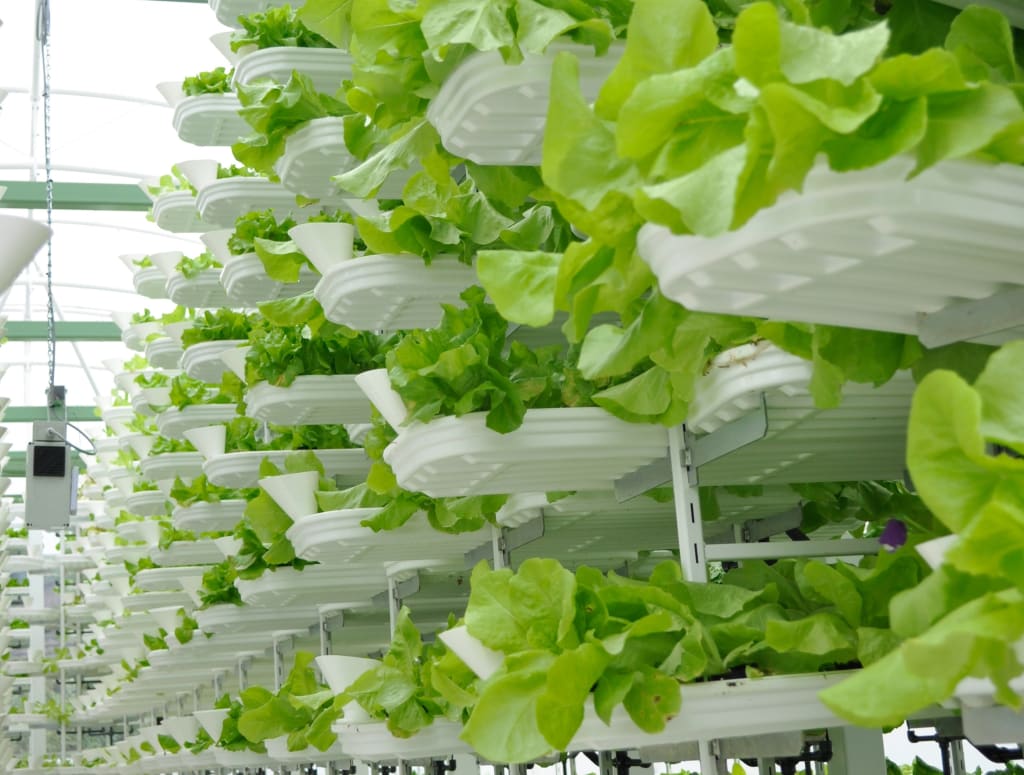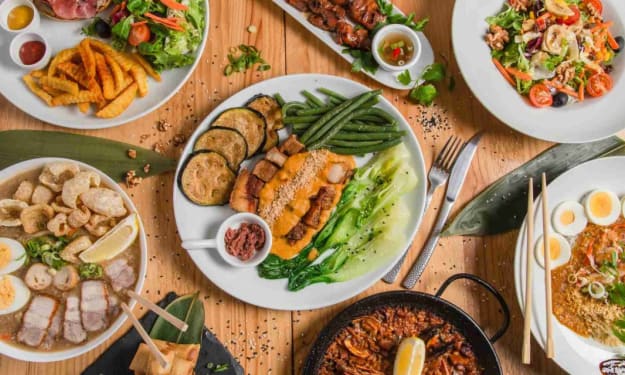How Will We Eat in the Future?
How the food on your plate will change.

The world’s population is increasing. It’s projected to rise from 7.4 billion people in 2016 to 9.2 billion people in 2050. That’s 1.8 billion extra mouths to feed in a world where, even now, people often go hungry. What’s needed is a revolution in how our food is grown, delivered and prepared. By using technology to further advance crop and meat production, the human race could create a sustainable future for not only our planet but for generations to come.
Vertical Farming
Vertical Farming is the process of growing plants in a controlled environment. As the name suggests, these farms are usually multi-story operations, with crops grown in long plastic trays. Vertical Farms are not dependant on weather conditions, politics, or climate change and can often use fewer resources than traditional agriculture. These farms have been theoretically possible for years, it’s only now that technology has caught up that it’s become practical to grow our food in this way.
The idea of Vertical Farms is to grow crops by controlling their environment, giving plants the exact nutrients, water, and light they need. When crops are grown outside, they are often in planted in soil. Sometimes this soil can be less than ideal for growth—it might be low in nutrients, or it could be the wrong type of soil for the plant you want to grow. Traditional farming can also use a lot of water. Crops are usually overwatered to compensate for water run off, and if the farmer chooses to use pesticides these dangerous chemicals can often end up in the run off as well, polluting wildlife areas, rivers, and bodies of water. This isn’t a problem for vertical farms. The farms don’t use soil as a growing medium. Instead the plants are sat suspended in trays with their roots exposed to water and nutrients. Hydroponics uses 70 percent less water than traditional farming and if the Vertical Farms choose to use aeroponics, with nutrients and water being delivered to them by a fine “mist,” this can reduce water usage by a further 70 percent. This also means that the plants are never without the nutrients they need to survive, allowing the crops to grow in the most productive way possible.
Critics of Vertical Farms often cite the use of artificial lights as a major drawback of growing crops in this way. After all, artificial lights are less efficient than the sun, which is both carbon neutral and free. Indoor farms, due to the very nature of them being inside, do need LEDs to deliver necessary light to plants. Often though Vertical Farms create bio gas from their waste products and they install solar panels. These methods can generate enough energy to sustain themselves and also give back to the grid.
With the ability of being able to farm anywhere, even in the suburbs of big metropolitan cities, transportation of produce will be cut down dramatically, further reducing the CO2 emissions from agriculture. Even crops that would traditionally be shipped from other continents, like avocados or coffee, would be able to be grown locally. For example, a Vertical Farm has been set up in an unused London Underground station, utilising space that otherwise would have been left empty. You can also see examples of old industrial estates being converted to VF’s all around the world.
Of course, this is all dependent on the financial viability of such facilities. Currently, with the need for such a large amount of energy, vertical farming is more expensive than traditional farming. The best crops to grow in these farms are baby greens, which have a traditionally higher price tag than other vegetables. As the technology to grow crops improves and the yield from Vertical Farms increases, vegetables grown in this way will become more affordable and much more economical as time goes on. A possible downside to VC’s would be if the farms themselves couldn’t create the energy they needed. This would force them to rely on the energy from the grid, where the majority of power is produced by burning fossil fuels. This would have a detrimental impact on the environment.
If VF’s do become more popular this could mean that land currently used for agricultural practices could be reclaimed by nature. Forests would be allowed to expand, meadows could grown uninterrupted and would allow animals and inspects to move back into their natural habitats. And the few crops that may need to be grown outside, mainly wheat, could add to the biodiversity rather than take away from it. All the added plants could take CO2 from the atmosphere and improve air quality, reducing the impact of Green house gas emissions from other industries.
Meet the New Meat
If vertical farming could sustain vegetable growth, then what about meat? Most people would agree that meat is a great way of delivering key nutrients to our bodies. But meat production is a very inefficient because animals are themselves inefficient. Take beef for instance. Cows are big animals and so need large quantities of food and water to keep them alive. To produce 1 pound of boneless beef takes 12 pounds of grain and 2500 gallons of water. A cow can grow to nearly 1 ton—that’s a lot of resources. Our appetite for meat doesn’t seem to be slowing down either, with meat becoming cheaper and cheaper to eat and produce. You can buy a McDonald’s cheese burger for 99p or a double cheeseburger for £1.29. With population increases, the situation is only set to get worse. And that’s just concentrating on beef: chicken, pork, and lamb are also inefficient ways of consuming calories, although to a lesser extent.
What can be done to reduce the impact meat production has on the earth? Some people tout insects as the way forward, but they're still living beings and aren’t suitable for everyone. It seems there are currently two ways to reduce the environmental impact of meat: Lab-grown meat or synthesising plant based protein. Both sound scary on the surface, but are actually very simple to understand.
Cultured Meat
(And no, that doesn’t mean itvisits the opera.)
Cultured meat is any meat that hasn’t been grown inside an animal. To most people that might sound like a scary nightmare akin to Frankenstein. But this kind of process has been used in medicine for a while, it’s just now becoming a viable way to produce meat at a large scale. In 1931, Winston Churchill predicted this technological advancement:
“We shall escape the absurdity of growing a whole chicken in order to eat the breast or wing, by growing these parts separately under a suitable medium.”
So how do they do it? Scientists take tissue samples from the animal they want to replicate, add proteins that encourage growth, then let the cells divide in muscle fibre. 10 pork muscle cells could divide and grown indefinitely and could produce 50,000 tons of meat over two months.
It becomes harder when you want to take the muscle fibre and turn it into the muscle tissue that we are more accustomed to. This would require the use of a circulatory system which would deliver nutrients, oxygen and take away waste products. The fibre would also need to be exercised in order to obtain the right texture.
2013 saw the world’s first lab-grown burger cooked and eaten in London. The €250,000 burger was said to have a definite meaty flavour and a good mouth feel. Food critic Hanni Ruetzler, who was able to eat the burger, said:
“There is really a bite to it, there is quite some flavour with the browning. I know there is no fat in it so I didn’t really know how juicy it would be, but there is quite some intense taste; it’s close to meat, it’s not that juicy, but the consistency is perfect. This is meat to me… It’s really something to bite on and I think the look is quite similar.”
This way of producing meat is also a lot more efficient than traditionally farmed cattle, with only 4% of the greenhouse gas emissions and a 45% reduction in energy needs. This massive reduction in greenhouse gases could mean it’s the most viable option for our meat eating habits, but it’s yet to be seen whether the paying public will trust this new meat and if it's able to scale to demand.
Plant Based Meat
Another way of creating a meat alternative is by using plant protein to replicate the protein structure of animal products. Unlike the lab based meat, plant based meat is available to buy today (although sadly not in the UK.) Plant-based meat differs to soy products by actually trying to mimic the structure of the food it’s trying to replace. Beyond Meat and Impossible Foods are currently competing in this space.
Both companies have slightly different processes. Impossible Burger uses mostly wheat, coconut oil, and potatoes and add their own plant based version of heme, the chemical that gives meat its properties. Beyond Meat uses mainly pea protein and add beetroot to give it a distinctive meaty look. Currently, Beyond Meat sells their Chicken strips and burger patties in stores around the US, whereas Impossible Burger is in limited restaurants in New York City, Los Angeles, and San Fransisco. Carnivores and vegetarians alike have favourably reviewed both companies on creating a very close alternative to meat.
As far as their green credentials go they’re both on the right track, with all their products using less water, land, and releasing fewer greenhouse gases than their “real world” equivalents.
It seems as if this process has come the closest to replicating the products we eat today. They’re both relatively new companies and, with time, prices of their products could be on par with other products made from animals.
What's the likelihood that this will become a reality?
As the Earth’s population rises, our appetite for meat and the way we currently grow vegetables and crops will become more of a strain on our planet. With the introduction of sustainable Vertical Farming, and with meat alternatives that are just as nutritious and taste as good as real meat, we could see a revolution in how we feed the world. It’s going to take a massive culture shift in the perception of how our food is produced. Maybe the majority of the world's population currently isn’t ready to change their eating habits but perhaps Vertical Farming, cultured meat, and plant based meat are the solution. Even if it’s not, something’s got to change before we run out of food and destroy the planet in the process.
About the Creator
Jamie Sergeant
Filmmaker, Writer and Storyteller.






Comments
There are no comments for this story
Be the first to respond and start the conversation.